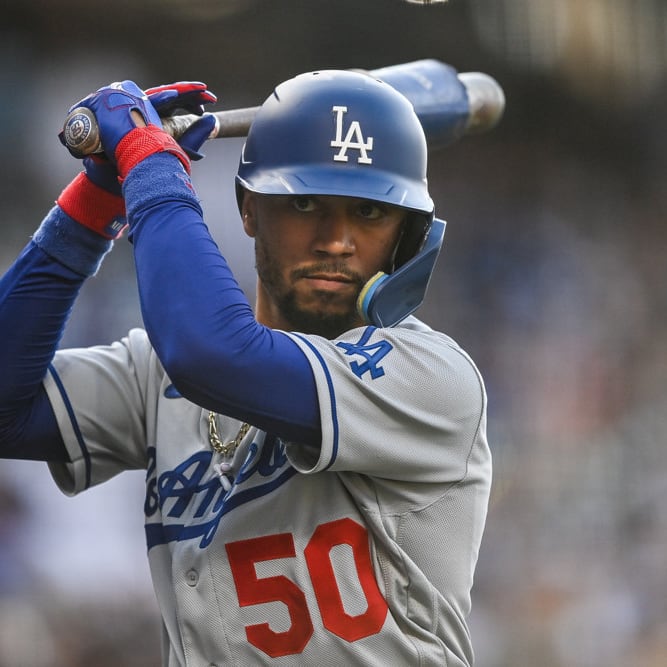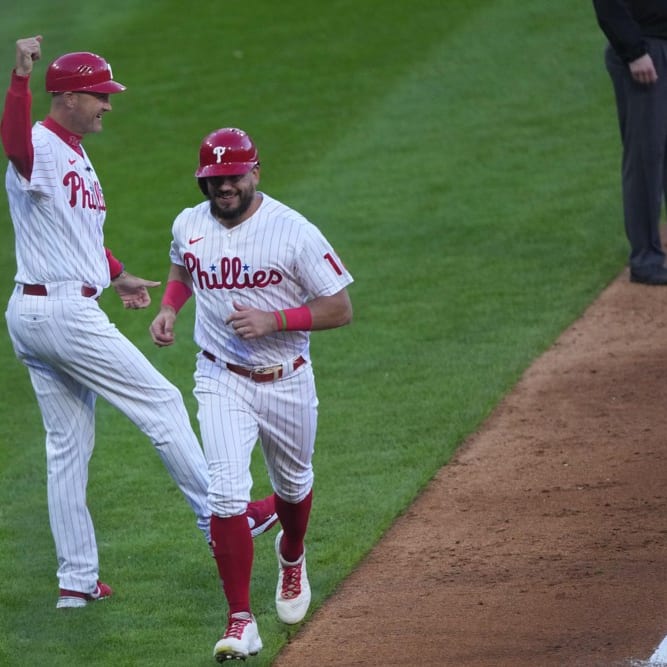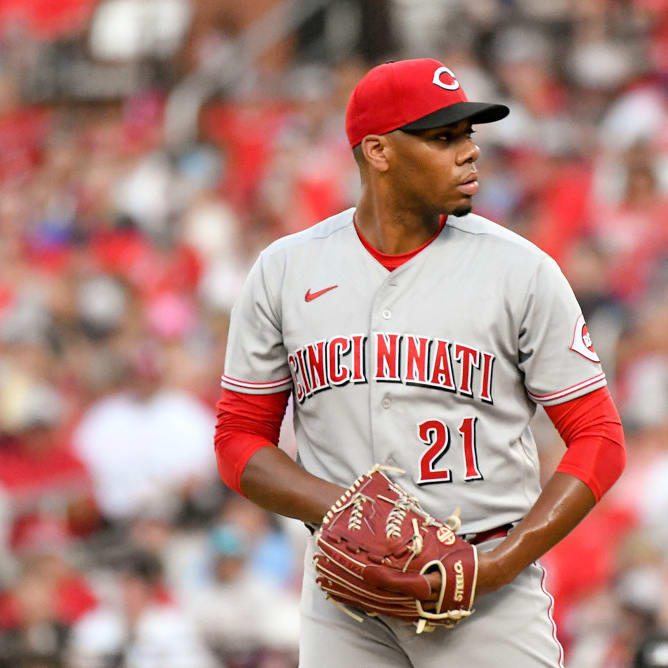This article is part of our Farm Futures series.
This isn't the best draft class for dynasty league purposes. The guys with the most exciting tools might not be able to hit, and a lot of the guys who should be able to hit for a high average are first basemen who may not hit for enough power to profile there. Additionally, two of the best hitting prospects in this draft -- Hunter Greene and Brendan McKay -- are likely to be developed as starting pitchers. Greene will almost certainly be drafted as a pitcher, as he can touch triple digits and has excellent command, but he could have had a chance to be an uber-athletic 30-homer shortstop if he were developed as a position player. McKay, who has roughly a 30 percent chance of being developed as a first baseman and not a left-handed starting pitcher, has one of the best hit tools in this class and the potential for 65-grade power. Losing Greene and presumably McKay to the mound takes some of the meat off the table in dynasty leagues.
Nonetheless, we are still two weeks away from getting a major injection of talent into the top 400 prospect rankings, with a handful of these guys likely to begin their pro careers in the top 100. Here are the 15 best hitting prospects in this year's class. Next week I will profile the best pitching prospects.
1. Royce Lewis, OF/SS, JSerra Catholic HS (Calif.)
Age: 17
Best offensive tool: Run
Draft pick range: 1-5
Likely
This isn't the best draft class for dynasty league purposes. The guys with the most exciting tools might not be able to hit, and a lot of the guys who should be able to hit for a high average are first basemen who may not hit for enough power to profile there. Additionally, two of the best hitting prospects in this draft -- Hunter Greene and Brendan McKay -- are likely to be developed as starting pitchers. Greene will almost certainly be drafted as a pitcher, as he can touch triple digits and has excellent command, but he could have had a chance to be an uber-athletic 30-homer shortstop if he were developed as a position player. McKay, who has roughly a 30 percent chance of being developed as a first baseman and not a left-handed starting pitcher, has one of the best hit tools in this class and the potential for 65-grade power. Losing Greene and presumably McKay to the mound takes some of the meat off the table in dynasty leagues.
Nonetheless, we are still two weeks away from getting a major injection of talent into the top 400 prospect rankings, with a handful of these guys likely to begin their pro careers in the top 100. Here are the 15 best hitting prospects in this year's class. Next week I will profile the best pitching prospects.
1. Royce Lewis, OF/SS, JSerra Catholic HS (Calif.)
Age: 17
Best offensive tool: Run
Draft pick range: 1-5
Likely placement in the top 400: 30-50
Lewis simply has the look of a future top-10 prospect in the game. He is a plus-plus runner, will play up the middle, likely moving off shortstop to center field, and has a lightning-quick bat that portends plus power down the road. He also won't turn 18 until June 5, making him one of the youngest prospects in this class, which only adds to the intrigue. There is a chance that he could strike out a little too much against upper-level pitching, but scouts are more confident in his hit tool than the other tooled-up prep hitters in this class. The power will have to come in order for him to profile as a star, and not just an above-average regular, but even if he never hits more than 15 homers in a season, his impact speed provides a nice fantasy floor.
2. Austin Beck, OF, North Davidson HS (N.C.)
Age: 18
Best offensive tool: Power
Draft range: 7-15
Likely placement in the top 400: 40-60
Beck oozes tools, but like many of the top non-1B hitting prospects in this class, there are significant questions about how much he will hit. He is reminiscent of Clint Frazier when he was a prep prospect, who was projected to go in the top 10 of the 2013 draft, where elite bat speed headlines the profile and the potential for plus power and plus speed is obvious. In his last high school game he belted three home runs, including a bomb to the opposite field, showcasing his all-fields power. His stock has continued to creep up as the lack of high-probability impact hitters in this class becomes more apparent. Beck tore the ACL and meniscus in his left knee last May, which means he has had fewer opportunities to silence those who doubt his hit tool, but also fewer opportunities to truly expose what could be a major weakness. There is a chance he hits in the .270-.280 range, and if that happens he could be a five-category fantasy star.
3. Adam Haseley, OF, Virginia
Age: 21
Best offensive tool: Hit
Draft range: 7-15
Likely placement in the top 400: 45-65
Haseley hit .399/.496/.676 with 14 home runs, 10 steals (on 14 attempts) and a 20:41 K:BB in 213 regular-season at-bats for the Cavaliers this season, emerging as a surefire first-round pick as an outfielder (he used to be considered a better prospect on the mound). There are some evaluators who think his power will be capped in the 15-to-20-homer range as a professional, but he has certainly unlocked more pop this season than many expected, and his strong forearms, quick bat and excellent approach are traits shared by many other hitters who have ended up overshooting their power projections. He is not a plus runner, but he has enough speed to steal 10-to-15 bases over a full year in his first handful of seasons in the big leagues. While he might be able to stick in center field, he lacks true impact defensive tools, which is the primary reason he is not being talked about as a potential top-five pick.
4. Nick Pratto, 1B, Huntington Beach HS (Calif.)
Age: 18
Best offensive tool: Hit
Draft range: 7-16
Likely placement in the top 400: 50-70
Pratto has all of the skills one looks for in a prep first base prospect. He showcases excellent command of the strike zone, is developing plus in-game power from the left side, offers plus defense and room for growth with the bat, as he was a legitimate two-way talent in high school. He is just 6-foot-1, 193 pounds, so he is not as big as the typical middle-of-the-order first baseman, which is why he is not projected to go in the first 10 picks. Still, from a fantasy perspective, the amount of hitters with the realistic potential to offer 60-grade power and 60-grade hit tools in this class can be counted on one hand, so Pratto should be valued highly even if he is unlikely to reach the majors until 2020 or 2021.
5. Jo Adell, OF, Ballard HS (Ky.)
Age: 18
Best offensive tool: Run
Draft range: 9-20
Likely placement in the top 400: 70-100
Adell draws comparisons to Byron Buxton and the Upton brothers, so dynasty league owners should have a pretty good idea what they are signing up for. The tools are jaw-dropping, with the potential for 65-grade speed, plus power and excellent outfield defense in either center or right field. However, scouts aren't sold on his ability to hit for a solid batting average. If they were, he'd be in the mix to go 1-1. He shouldn't be anyone's top target from this class, but if he falls too far in dynasty league drafts, it's worth remembering that his stock has the potential to explode if he hits in the lower levels, so owners might be able to cash out for a profit before he faces upper-level pitching.
6. Pavin Smith, 1B, Virginia
Age: 21
Best offensive tool: Hit
Draft range: 6-10
Likely placement in the top 400: 80-110
It is easy to see why scouts like Smith. He hit .346/.429/.571 with 12 home runs in 217 at-bats in his junior year at Virginia, and struck out just nine times. That combination of production and plate discipline is a rare commodity, and could be enough for a team picking in the top-15 to overlook the fact that college first basemen have a pretty high bust rate. Smith is a solid athlete and an above-average defender at first base, so as long as he continues to really hit against professional pitching, he should be able to make it as at least an average regular. The majority of scouts see him offering 50-grade or 55-grade power down the road, although there are those who see him topping those grades. From a fantasy perspective, it is a little concerning that he falls into the hit-over-power subset of first base prospects, as that puts an awful lot of pressure on his approach and hit tool. If you loved Matt Thaiss coming out of Virginia last year, then Smith should be right up your alley.
7. Mark Vientos, 3B, American Heritage HS (Fla.)
Age: 17
Best offensive tool: Power
Draft range: 20-40
Likely placement in the top 400: 80-110
The youngest player expected to come off the board in the first three rounds of the draft, Vientos is already on the verge of outgrowing shortstop, but the selling point here is the loud raw power. He should be able to handle third base, and has a chance to be a middle-of-the-order threat. It is not clear where his batting average will settle, but if he hits .260 or .270, there should be enough production for him to be an average or better regular. His youth means that he will require extreme patience, and he may not be assigned to a full-season affiliate until sometime next summer. He will not be a threat on the bases.
8. Jeren Kendall, OF, Vanderbilt
Age: 21
Best offensive tool: Run
Draft range: 9-15
Likely placement in the top 400: 100-150
Kendall has the crazy tools (plus-plus speed, plus bat speed, plus raw power) and shaky hit tool that are typically associated with athletic prep position players, but he is already 21. If I'm betting on tools and the development of a hit tool, I'd rather bet on an 18-year-old figuring things out under professional coaching. It is very hard to bet on college hitters who don't project to have at least a 50-grade hit tool. Kendall led the Commodores with 67 strikeouts in 235 at-bats in the regular season. This could end up being a slightly better version the Buddy Reed skill set from last year's draft. Of course, if he hits against pro pitching, he could easily be the best fantasy prospect in this class. We should have a pretty good idea by this time next season whether Kendall profiles as a potential dynasty league building block or can be cut loose in shallower leagues.
9. Bubba Thompson, OF, McGill-Toolen HS (Ala.)
Age: 18
Best offensive tool: Run
Draft range: 15-25
Likely placement in the top 400: 100-150
Thompson is another toolsy prep outfielder with questions about his hit tool. He may take some time to really gain steam as a prospect, but with 65-grade speed, some power projection and a really lean, athletic frame that should age well, he is a worthwhile stash in deeper leagues. A former two-sport star who could have played quarterback in the SEC, Thompson may be able to refine his baseball skills with professional coaching and 100 percent focus on baseball.
10. Jake Burger, 3B, Missouri State
Age: 21
Best offensive tool: Power
Draft range: 15-25
Likely placement in the top 400: 180-250
The aptly named Burger is a bad-bodied college hitter with big game power and questions about his hit tool and defensive home. His 22 home runs and 32:41 K:BB in 223 at-bats this season are certainly encouraging, but it's not like he has been facing stiff competition in the Missouri Valley Conference. There are those who think he can handle third base long term, which would be huge, as the offensive profile could be a little light for first base. He could also chip in a sneaky handful of steals in his early years.
11. Keston Hiura, 2B, UC Irvine
Age: 20
Best offensive tool: Hit
Draft range: 15-35
Likely placement in the top 400: 200-300
Hiura has one of the best hit tools in the class, and has a chance to develop 55 or 60-grade power with a little speed mixed in. Unfortunately, he will likely be limited to second base or left field, and and he may end up needing Tommy John surgery after he gets drafted (an elbow injury has limited him to DH duty this spring). In deeper leagues, his hit tool is worth sitting on, even if he undergoes surgery, but there are plenty of red flags here.
12. Evan White, 1B, Kentucky
Age: 21
Best offensive tool: Hit
Draft range: 15-30
Likely placement in the top 400: 200-300
White is the type of prospect whose stock will creep up if a team like the Dodgers drafts him, but skepticism will set in if he is popped by a team like the Marlins. His offensive and defensive tools are incredibly unique, as he is one of the best pure college hitters in the class, is a plus runner, and boasts only average power. While he can handle the outfield, he is a potential Gold Glove-caliber defender at first base. To further complicate matters, he bats right-handed and throws left-handed, which is a rarity for first base prospects. In a perfect world, the team that drafts him will give him at least 20 starts in the outfield each year so that he can qualify there, which is a possibility. If he is confined to first base, however, he will likely have to outperform power projections in order to be valuable in 15-team leagues.
13. Drew Waters, OF, Etowah HS (Ga.)
Age: 18
Best offensive tool: Run
Draft range: 25-50
Likely placement in the top 400: 250-350
Waters is the best switch hitter in the class, profiling as a potential .280 hitter with above average to plus power, particularly against right-handed pitching. He is also a plus runner, so there are plenty of tools to get excited about. He will need to keep his strikeout rate in check in the lower levels in order to get his tools to play in games early on.
14. Heliot Ramos, OF, Martinez HS (P.R.)
Age: 17
Best offensive tool: Power
Draft range: 20-40
Likely placement in the top 400: 250-350
Ramos is the best Puerto Rican prospect in this year's class, but he is a true boom or bust hitter. He has mammoth raw power, but is incredibly raw at the plate, and could stand to work in the complex leagues until being assigned to a rookie league next summer. The payoff could be huge, but there is too much risk and too long of a lead time to invest in Ramos in leagues where 200 or fewer prospects are rostered.
15. Ryan Vilade, 3B, Stillwater HS (Okla.)
Age: 18
Best offensive tool: Power
Draft range: 25-50
Likely placement in the top 400: 250-350
Vilade has a very pretty right-handed swing that should be able to produce 25-homer power down the road. He will move off shortstop to third base or second base after getting drafted, and while he has enough power to profile at either position, maintaining a manageable strikeout rate will be critical if he is to make it as an everyday player. He could end up being a .260 hitter who hits sixth in a quality big-league lineup and is a perennial 25-homer/80-RBI threat.










